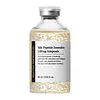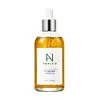What's inside
What's inside
 Key Ingredients
Key Ingredients

 Benefits
Benefits

 Concerns
Concerns

No concerns
 Ingredients Side-by-side
Ingredients Side-by-side

Water
Skin ConditioningButylene Glycol
HumectantGlycerin
HumectantMethylpropanediol
Solvent1,2-Hexanediol
Skin ConditioningNiacinamide
SmoothingCarbomer
Emulsion StabilisingTromethamine
BufferingPPG-13-Decyltetradeceth-24
EmulsifyingHydroxyethylcellulose
Emulsion StabilisingSilk Extract
Skin ConditioningAdenosine
Skin ConditioningIron Powder
Agar
MaskingEthylhexylglycerin
Skin ConditioningDisodium EDTA
Acrylates/C10-30 Alkyl Acrylate Crosspolymer
Emulsion StabilisingSynthetic Fluorphlogopite
Betaine
HumectantPanthenol
Skin ConditioningHydrolyzed Elastin
EmollientTitanium Dioxide
Cosmetic ColorantCI 77491
Cosmetic ColorantMica
Cosmetic ColorantGellan Gum
Hydrolyzed Collagen
EmollientCentella Asiatica Extract
CleansingPropanediol
SolventMagnesium Ascorbyl Phosphate
AntioxidantPolygonum Fagopyrum Seed Extract
Skin ConditioningLecithin
EmollientAcetyl Glutamine
Skin ConditioningPhenoxyethanol
PreservativeArtemisia Vulgaris Extract
Skin ConditioningSodium Hyaluronate
HumectantCaprylyl Glycol
EmollientTin Oxide
AbrasiveGold
Cosmetic ColorantSqualane
EmollientHydrogenated Polyisobutene
EmollientBenzyl Glycol
SolventSh-Oligopeptide-1
Skin ConditioningSh-Polypeptide-1
Skin ConditioningSh-Oligopeptide-2
Skin ConditioningSh-Polypeptide-11
Sh-Polypeptide-9
Skin ConditioningBacillus
Skin ConditioningHydrolyzed Glycosaminoglycans
HumectantCollagen
MoisturisingTocopherol
AntioxidantSodium Hyaluronate Crosspolymer
HumectantCaffeoyl Hexapeptide-65
AntimicrobialHydrolyzed Hyaluronic Acid
HumectantSh-Decapeptide-7
AntioxidantSh-Octapeptide-4
AntioxidantSh-Oligopeptide-9
HumectantSh-Pentapeptide-19
Skin ConditioningHydroxypropyltrimonium Hyaluronate
Palmitoyl Pentapeptide-4
Skin ConditioningAcetyl Hexapeptide-8
HumectantCopper Tripeptide-1
Skin ConditioningHyaluronic Acid
HumectantUlmus Davidiana Root Extract
Skin ConditioningSodium Acetylated Hyaluronate
HumectantWater, Butylene Glycol, Glycerin, Methylpropanediol, 1,2-Hexanediol, Niacinamide, Carbomer, Tromethamine, PPG-13-Decyltetradeceth-24, Hydroxyethylcellulose, Silk Extract, Adenosine, Iron Powder, Agar, Ethylhexylglycerin, Disodium EDTA, Acrylates/C10-30 Alkyl Acrylate Crosspolymer, Synthetic Fluorphlogopite, Betaine, Panthenol, Hydrolyzed Elastin, Titanium Dioxide, CI 77491, Mica, Gellan Gum, Hydrolyzed Collagen, Centella Asiatica Extract, Propanediol, Magnesium Ascorbyl Phosphate, Polygonum Fagopyrum Seed Extract, Lecithin, Acetyl Glutamine, Phenoxyethanol, Artemisia Vulgaris Extract, Sodium Hyaluronate, Caprylyl Glycol, Tin Oxide, Gold, Squalane, Hydrogenated Polyisobutene, Benzyl Glycol, Sh-Oligopeptide-1, Sh-Polypeptide-1, Sh-Oligopeptide-2, Sh-Polypeptide-11, Sh-Polypeptide-9, Bacillus, Hydrolyzed Glycosaminoglycans, Collagen, Tocopherol, Sodium Hyaluronate Crosspolymer, Caffeoyl Hexapeptide-65, Hydrolyzed Hyaluronic Acid, Sh-Decapeptide-7, Sh-Octapeptide-4, Sh-Oligopeptide-9, Sh-Pentapeptide-19, Hydroxypropyltrimonium Hyaluronate, Palmitoyl Pentapeptide-4, Acetyl Hexapeptide-8, Copper Tripeptide-1, Hyaluronic Acid, Ulmus Davidiana Root Extract, Sodium Acetylated Hyaluronate
Water
Skin ConditioningGlycerin
HumectantButylene Glycol
HumectantDipropylene Glycol
Humectant1,2-Hexanediol
Skin ConditioningNiacinamide
SmoothingPolyglycerin-3
HumectantAdenosine
Skin ConditioningBeta-Glucan
Skin ConditioningArginine
MaskingDipotassium Glycyrrhizate
HumectantSodium Hyaluronate
HumectantMallotus Japonicus Bark Extract
Skin ConditioningYeast Extract
Skin ConditioningHelichrysum Arenarium Extract
AntiseborrhoeicCopper Tripeptide-1
Skin ConditioningAcetyl Tetrapeptide-2
Skin ConditioningCarbomer
Emulsion StabilisingDextran
Hydroxyethylcellulose
Emulsion StabilisingCaramel
Cosmetic ColorantGlyceryl Acrylate/Acrylic Acid Copolymer
HumectantTrifluoroacetyl Tripeptide-2
Skin ConditioningXanthan Gum
EmulsifyingBoron Nitride
AbsorbentPvm/Ma Copolymer
Emulsion StabilisingAgar
MaskingGellan Gum
Calcium Alginate
MaskingCaprylyl Glycol
EmollientGlucosylrutin
AntioxidantPalmitoyl Tripeptide-5
Skin ConditioningTetradecyl Aminobutyroylvalylaminobutyric Urea Trifluoroacetate
Skin ConditioningMagnesium Chloride
Disodium EDTA
Water, Glycerin, Butylene Glycol, Dipropylene Glycol, 1,2-Hexanediol, Niacinamide, Polyglycerin-3, Adenosine, Beta-Glucan, Arginine, Dipotassium Glycyrrhizate, Sodium Hyaluronate, Mallotus Japonicus Bark Extract, Yeast Extract, Helichrysum Arenarium Extract, Copper Tripeptide-1, Acetyl Tetrapeptide-2, Carbomer, Dextran, Hydroxyethylcellulose, Caramel, Glyceryl Acrylate/Acrylic Acid Copolymer, Trifluoroacetyl Tripeptide-2, Xanthan Gum, Boron Nitride, Pvm/Ma Copolymer, Agar, Gellan Gum, Calcium Alginate, Caprylyl Glycol, Glucosylrutin, Palmitoyl Tripeptide-5, Tetradecyl Aminobutyroylvalylaminobutyric Urea Trifluoroacetate, Magnesium Chloride, Disodium EDTA
 Reviews
Reviews

Ingredients Explained
These ingredients are found in both products.
Ingredients higher up in an ingredient list are typically present in a larger amount.
1,2-Hexanediol is a synthetic liquid and another multi-functional powerhouse.
It is a:
- Humectant, drawing moisture into the skin
- Emollient, helping to soften skin
- Solvent, dispersing and stabilizing formulas
- Preservative booster, enhancing the antimicrobial activity of other preservatives
Adenosine is in every living organism. It is one of four components in nucleic acids that helps store our DNA.
Adenosine has many benefits when used. These benefits include hydrating the skin, smoothing skin, and reducing wrinkles. Once applied, adenosine increases collagen production. It also helps with improving firmness and tissue repair.
Studies have found adenosine may also help with wound healing.
In skincare products, Adenosine is usually derived from yeast.
Learn more about AdenosineAgar is the vegan substitute for animal-gelatin. It helps thicken and improve the texture of cosmetics. It comes from cell-walls of red algae.
Butylene Glycol (or BG) is used within cosmetic products for a few different reasons:
Overall, Butylene Glycol is a safe and well-rounded ingredient that works well with other ingredients.
Though this ingredient works well with most skin types, some people with sensitive skin may experience a reaction such as allergic rashes, closed comedones, or itchiness.
Learn more about Butylene GlycolCaprylyl Glycol is a humectant and emollient, meaning it attracts and preserves moisture.
It is a common ingredient in many products, especially those designed to hydrate skin. The primary benefits are retaining moisture, skin softening, and promoting a healthy skin barrier.
Though Caprylyl Glycol is an alcohol derived from fatty acids, it is not the kind that can dry out skin.
This ingredient is also used as a preservative to extend the life of products. It has slight antimicrobial properties.
Learn more about Caprylyl GlycolCarbomer is a polymer of acrylic acid. Its main role is to create a gel consistency.
A high amount of carbomer can cause pilling or balling up of products. Don't worry, most products contain 1% or less of carbomer.
Copper Tripeptide-1 (GHK-Cu) is a skin repairing ingredient known for its ability to boost collagen, improve firmness, and support skin regeneration.
It is a complex made up of a naturally occurring peptide (glycine-histidine-lysine) and copper, an essential trace element.
While studying wound healing, researchers noticed GHK-Cu stimulated hair follicle enlargement and growth by keeping hair in its active growth phase longer. This has made it a promising ingredient for hair regrowth treatments.
Some people have reported increased facial hair. While GHK-Cu can make your hair follicles bigger, it usually doesn’t turn soft, barely-visible facial hairs into thick, dark ones.
Anecdotal reports suggest that overusing copper peptides might lead to premature aging due to excess free copper or enzyme imbalances. This claim isn’t backed by large-scale studies.
Unfortunately, there are limited human studies for this ingredient. While early results are promising, many studies are either small, in-vitro, or not rigorously controlled.
For example, there is a 1998 study that explored the effects of copper tripeptide, vitamin C, tretinoin, and melatonin on skin repair and collagen synthesis.
After one month, increased procollagen production was seen in 7 out of 10 participants using copper tripeptide (more than those using vitamin C, melatonin, or tretinoin.
While the study was exploratory, it offers early evidence that copper tripeptide may support collagen production. Larger, well-designed trials are still needed to confirm its potential and understand individual responses.
Read more about other common types of peptides here:
Learn more about Copper Tripeptide-1Disodium EDTA plays a role in making products more stable by aiding other preservatives.
It is a chelating agent, meaning it neutralizes metal ions that may be found in a product.
Disodium EDTA is a salt of edetic acid and is found to be safe in cosmetic ingredients.
Learn more about Disodium EDTAGellan Gum is a high-molecular weight heteropolysaccharide gum. It is created by the process of pure-culture fermentation with the bacterium Pseudomonas elodea.
Gellan Gum is used to stabilize products. This helps improve the texture, consistency, and shelf life.
Glycerin is already naturally found in your skin. It helps moisturize and protect your skin.
A study from 2016 found glycerin to be more effective as a humectant than AHAs and hyaluronic acid.
As a humectant, it helps the skin stay hydrated by pulling moisture to your skin. The low molecular weight of glycerin allows it to pull moisture into the deeper layers of your skin.
Hydrated skin improves your skin barrier; Your skin barrier helps protect against irritants and bacteria.
Glycerin has also been found to have antimicrobial and antiviral properties. Due to these properties, glycerin is often used in wound and burn treatments.
In cosmetics, glycerin is usually derived from plants such as soybean or palm. However, it can also be sourced from animals, such as tallow or animal fat.
This ingredient is organic, colorless, odorless, and non-toxic.
Glycerin is the name for this ingredient in American English. British English uses Glycerol/Glycerine.
Learn more about GlycerinHydroxyethylcellulose is used to improve the texture of products. It is created from a chemical reaction involving ethylene oxide and alkali-cellulose. Cellulose is a sugar found in plant cell walls and help give plants structure.
This ingredient helps stabilize products by preventing ingredients from separating. It can also help thicken the texture of a product.
This ingredient can also be found in pill medicines to help our bodies digest other ingredients.
Learn more about HydroxyethylcelluloseNiacinamide is a multitasking form of vitamin B3 that strengthens the skin barrier, reduces pores and dark spots, regulates oil, and improves signs of aging.
And the best part? It's gentle and well-tolerated by most skin types, including sensitive and reactive skin.
You might have heard of "niacin flush", or the reddening of skin that causes itchiness. Niacinamide has not been found to cause this.
In very rare cases, some individuals may not be able to tolerate niacinamide at all or experience an allergic reaction to it.
If you are experiencing flaking, irritation, and dryness with this ingredient, be sure to double check all your products as this ingredient can be found in all categories of skincare.
When incorporating niacinamide into your routine, look out for concentration amounts. Typically, 5% niacinamide provides benefits such as fading dark spots. However, if you have sensitive skin, it is better to begin with a smaller concentration.
When you apply niacinamide to your skin, your body converts it into nicotinamide adenine dinucleotide (NAD). NAD is an essential coenzyme that is already found in your cells as "fuel" and powers countless biological processes.
In your skin, NAD helps repair cell damage, produce new healthy cells, support collagen production, strengthen the skin barrier, and fight environmental stressors (like UV and pollution).
Our natural NAD levels start to decline with age, leading to slower skin repair, visible aging, and a weaker skin barrier. By providing your skin niacinamide, you're recharging your skin's NAD levels. This leads to stronger, healthier, and younger looking skin.
Another name for vitamin B3 is nicotinamide. This vitamin is water-soluble and our bodies don't store it. We obtain Vitamin B3 from either food or skincare. Meat, fish, wheat, yeast, and leafy greens contain vitamin B3.
The type of niacinamide used in skincare is synthetically created.
Learn more about NiacinamideSodium Hyaluronate is hyaluronic acid's salt form. It is commonly derived from the sodium salt of hyaluronic acid.
Like hyaluronic acid, it is great at holding water and acts as a humectant. This makes it a great skin hydrating ingredient.
Sodium Hyaluronate is naturally occurring in our bodies and is mostly found in eye fluid and joints.
These are some other common types of Hyaluronic Acid:
Learn more about Sodium HyaluronateWater. It's the most common cosmetic ingredient of all. You'll usually see it at the top of ingredient lists, meaning that it makes up the largest part of the product.
So why is it so popular? Water most often acts as a solvent - this means that it helps dissolve other ingredients into the formulation.
You'll also recognize water as that liquid we all need to stay alive. If you see this, drink a glass of water. Stay hydrated!
Learn more about Water